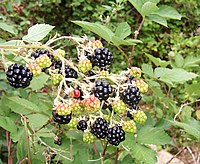
Photo from wikipedia
Antioxidant activity associated with green rooibos infusions is attributed to the activity of polyphenols, particularly aspalathin and nothofagin. This study aimed to optimise β-cyclodextrin (β-CD)-assisted extraction of crude green rooibos… Click to show full abstract
Antioxidant activity associated with green rooibos infusions is attributed to the activity of polyphenols, particularly aspalathin and nothofagin. This study aimed to optimise β-cyclodextrin (β-CD)-assisted extraction of crude green rooibos (CGRE) via total polyphenolic content (TPC) and antioxidant activity assays. Response surface methodology (RSM) permitted optimisation of β-CD concentration (0–15 mM), temperature (40–90 °C) and time (15–60 min). Optimal extraction conditions were: 15 mM β-CD: 40 °C: 60 min with a desirability of 0.985 yielding TPC of 398.25 mg GAE·g−1, metal chelation (MTC) of 93%, 2,2′-azino-bis(3-ethylbenzothiazoline-6-sulfonic acid) (ABTS) radical scavenging of 1689.7 µmol TE·g−1, ferric reducing antioxidant power (FRAP) of 2097.53 µmol AAE·g−1 and oxygen radical absorbance capacity (ORAC) of 11,162.82 TE·g−1. Aspalathin, hyperoside and orientin were the major flavonoids, with quercetin, luteolin and chrysoeriol detected in trace quantities. Differences (p < 0.05) between aqueous and β-CD assisted CGRE was only observed for aspalathin reporting the highest content of 172.25 mg·g−1 of dry matter for extracts produced at optimal extraction conditions. Positive, strong correlations between TPC and antioxidant assays were observed and exhibited regression coefficient (R2) between 0.929–0.978 at p < 0.001. These results demonstrated the capacity of β-CD in increasing polyphenol content of green rooibos.
Journal Title: Molecules
Year Published: 2022
Link to full text (if available)
Share on Social Media: Sign Up to like & get
recommendations!